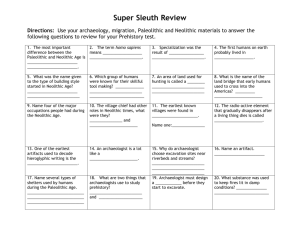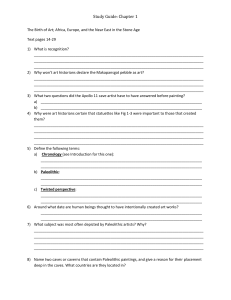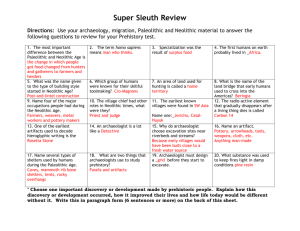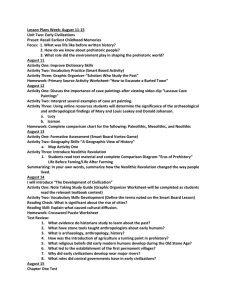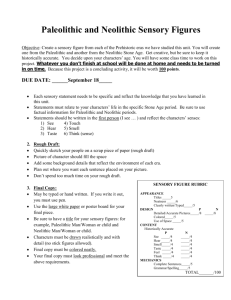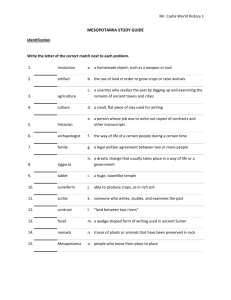AP Art History Chapter 1- Prehistoric Art STUDY GUIDE Chapter 1
advertisement
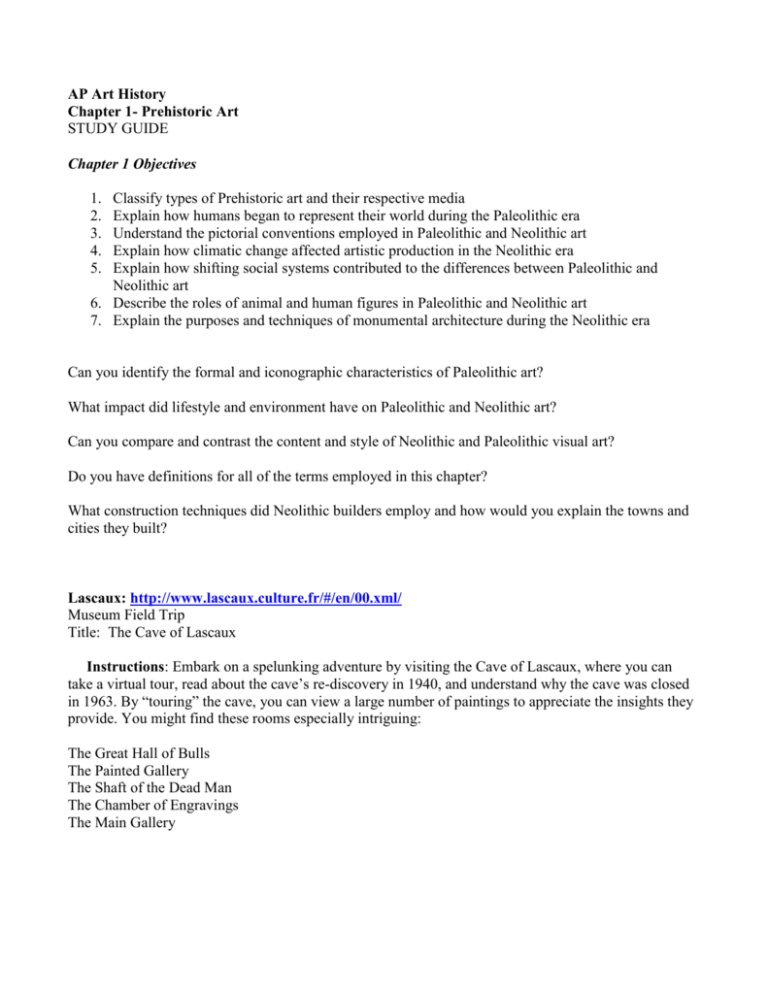
AP Art History
Chapter 1- Prehistoric Art
STUDY GUIDE
Chapter 1 Objectives
1.
2.
3.
4.
5.
Classify types of Prehistoric art and their respective media
Explain how humans began to represent their world during the Paleolithic era
Understand the pictorial conventions employed in Paleolithic and Neolithic art
Explain how climatic change affected artistic production in the Neolithic era
Explain how shifting social systems contributed to the differences between Paleolithic and
Neolithic art
6. Describe the roles of animal and human figures in Paleolithic and Neolithic art
7. Explain the purposes and techniques of monumental architecture during the Neolithic era
Can you identify the formal and iconographic characteristics of Paleolithic art?
What impact did lifestyle and environment have on Paleolithic and Neolithic art?
Can you compare and contrast the content and style of Neolithic and Paleolithic visual art?
Do you have definitions for all of the terms employed in this chapter?
What construction techniques did Neolithic builders employ and how would you explain the towns and
cities they built?
Lascaux: http://www.lascaux.culture.fr/#/en/00.xml/
Museum Field Trip
Title: The Cave of Lascaux
Instructions: Embark on a spelunking adventure by visiting the Cave of Lascaux, where you can
take a virtual tour, read about the cave’s re-discovery in 1940, and understand why the cave was closed
in 1963. By “touring” the cave, you can view a large number of paintings to appreciate the insights they
provide. You might find these rooms especially intriguing:
The Great Hall of Bulls
The Painted Gallery
The Shaft of the Dead Man
The Chamber of Engravings
The Main Gallery
AP Art History
burin
composite
view
composition
cromlech
freestanding
sculpture
ground line
Henge
High relief
Incise
landscape
lintel
Low relief
Medium
megalith
(adj.,
megalithic)
Mesolithic
monolith
Mural
Neolithic
Paleolithic
Radiocarbon
dating
Relief
Terracotta
Trilithons
Twisted
perspective
(2 points each)
/48
(2 pts each)
.
Chapter One- Vocabulary
1. Around what date are human beings thought to have intentionally created art works?
2. What subject was most often depicted by Paleolithic artists?
3. What interpretations have been given to figures like the one from Hohlenstein-Stadel illustrated in
FIG 1-3?
4. Name three caves or caverns that contain Paleolithic paintings, and give a reason for their
placement deep in the caves.
5. Describe the organization of the bison images from Altamira FIG 1-9 . Are they composed as a
single composition? What viewpoint does the artist take when describing the animals?
6. The cavern of Pech-Merle contains a number of handprints, some of which are described as
"negative" (FIG 1-10) others as "positive. " What techniques did the artists apparently use to
create these prints? What are they thought to have meant?
NEOLITHIC ART
(3 pts each)
1.
List two important Neolithic sites in the ancient Near East:
a.
b.
.
2. What purpose do you think the figure from Ain Ghazal (FIG. 1-15) might have served?
3. List three changes in artistic production that paralleled the shift from a food-gathering to a
food-producing society.
a.
b.
c.
4. Approximately when and why was Stonehenge thought to have been erected?
Resources:
Ain Ghazal Excavation Reports http://menic.utexas.edu/ghazal/
Information on the Neolithic site in Jordan.
Lascaux: Discover http://www.culture.gouv.fr/culture/arcnat/lascaux/en/f-dec.htm
History and images of the Palaeolithic cave in France.
Pech-Merle Prehistory Center http://www.quercy.net/pechmerle/english/visite.html
Images and information regarding the archaeological finds at the Pech-Merle cave in France.
The Cave of Chauvet-Point-d’Arc http://www.culture.gouv.fr/culture/arcnat/chauvet/en/index.html
Information on the art found in the French cave, and data on the archaeological processes and methods.
The Neolithic Village at Skara Brae http://www.orkneyjar.com/history/skarabrae/
Images and information on the Neolithic Scottish village.
Çatal Höyük: Excavations of a Neolithic Anatolian Höyük http://www.catalhoyuk.com/
Provides info on the ongoing project at Çatal including images, research, news, and history.
Short Answer Topics:
*(5pts) What changes occurred between the Paleolithic ('Old Stone Age') to the Neolithic ('New Stone
Age') period?
*( 3pts) Explain why calling a prehistoric figure a "woman" instead of "Venus" frees us to think about
the object in new and different ways.
Select two of the following three: (5 pts each)
Refer to at least three works of art in explaining how Paleolithic works of art show an aesthetic sense.
What evidence is there that some megalithic monuments, such as Stonehenge, may have had a
relationship to celestial events in the calendar?
Compare any prehistoric work to something that is created in present day.
DISCUSSION QUESTION (10 pts)
1. Briefly describe the differences between the so-called Venus of Willendorf (FIG. 1-4) and the
relief of the Woman from Laussel (Fig. 1-5)? When comparing two figures you can begin with
facts like size, material and technique, approximate date, and what is known about where
they were found. Then go on to describe the bodily features of each figure and how the
similarities and differences might be interpreted.

